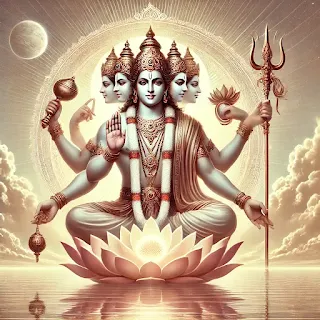Mangal Stotra - Vedic Mantra
Author: Shweta Goyal
 |
| "Mangal Stotra - A powerful image of Lord Mangal, embodying strength, courage, and protection through the Mangal Stotra." |
Introduction
The Mangal Stotra is a revered hymn dedicated to Lord Mangal (Mars), one of the nine celestial bodies (Navagrahas) in Hindu astrology. Mangal is known as the god of war, strength, and courage, and is believed to influence one’s energy, vitality, and determination. The Mangal Stotra is chanted to appease Mars, seeking his blessings for strength, success, and protection from the malefic effects of Mangal Dosh or other unfavorable planetary positions. This powerful hymn is believed to bring relief from challenges, obstacles, and disputes, and to enhance one’s physical and mental strength.
Mantra Text
Here is an excerpt from the Mangal Stotra:
धरणीगर्भसम्भूतं विद्युत्कान्तिसमप्रभम्।
कुमारं शक्तिहस्तं च मंगलं प्रणमाम्यहम्॥
Dharanīgarbhasambhūtaṃ Vidyutkāntisamaprabham
Kumāraṃ Śaktihastaṃ Ca Maṅgalaṃ Praṇamāmyaham
Meaning and Significance
The Mangal Stotra is a hymn that praises the various attributes and deeds of Lord Mangal. The key themes include:
- **Dharanīgarbhasambhūtaṃ**: The hymn describes Mangal as born from the womb of the earth, symbolizing his connection to physical strength and vitality.
- **Vidyutkāntisamaprabham**: Mangal is praised for his brilliance, comparable to that of lightning, representing his energy and determination.
- **Kumāraṃ Śaktihastaṃ**: The hymn highlights Mangal as the youthful warrior with strength in his hands, signifying his role as a protector and fighter.
- **Maṅgalaṃ**: Mangal is revered as the one who brings auspiciousness, ensuring success and overcoming obstacles.
Chanting this mantra is believed to invoke divine strength, courage, and protection from challenges.
Benefits of Chanting
Chanting the Mangal Stotra offers numerous benefits, particularly for those seeking strength, courage, and protection from the adverse effects of Mars:
- **Relief from Mangal Dosh**: The hymn is believed to reduce the malefic effects of Mangal Dosh and other unfavorable Mars influences.
- **Physical and Mental Strength**: Regular recitation enhances physical strength, vitality, and mental determination.
- **Overcoming Obstacles**: The hymn helps in overcoming challenges and obstacles in various aspects of life.
- **Success in Ventures**: Chanting the Mangal Stotra ensures success in endeavors requiring courage and strength.
- **Protection and Victory**: The hymn provides protection in conflicts and disputes, ensuring victory and success.
How to Chant the Stotram
To fully benefit from chanting the Mangal Stotra, follow these guidelines:
- **Best Time to Chant**: Early morning or during the evening, particularly on Tuesdays, is considered ideal for chanting the stotra.
- **Number of Repetitions**: Chanting the stotra once daily is common, but it can be recited multiple times for enhanced blessings.
- **Rituals**: Light a lamp and incense in front of an image or idol of Mangal. Offer red flowers, lentils, and sweets while chanting with devotion.
- **Posture**: Sit in a comfortable position with a straight spine, focusing on Mangal’s image or symbol, and chant with full concentration and sincerity.
Mythological Background
The Mangal Stotra is traditionally chanted during Mangal Puja, especially on Tuesdays, which are dedicated to the worship of Lord Mangal. According to Hindu tradition, Mangal is the son of the Earth Goddess (Bhumi) and is known as the god of war, representing strength, courage, and determination. The Mangal Stotra is a means to seek his favor and blessings, ensuring protection from the malefic effects of Mars and leading a life of success, vitality, and inner strength.
Conclusion
The Mangal Stotra is a powerful devotional hymn that offers strength, courage, and protection from the adverse effects of Mars. By incorporating this stotra into your daily practice, especially on Tuesdays, you can align yourself with the divine energy of Mangal, ensuring a life of success, vitality, and inner harmony. Chant the Mangal Stotra with faith and devotion, and experience the transformative power of Mangal’s blessings.
Mangal Stotra - Author: Shweta Goyal
Meta Information
Meta Title: Mangal Stotra - Powerful Vedic Hymn for Strength and Courage
Meta Description: Discover the meaning, significance, and benefits of chanting the Mangal Stotra, a powerful Vedic hymn for invoking the blessings of Lord Mangal for strength, courage, and protection from the adverse effects of Mars.
Keywords: Mangal Stotra, Vedic Mantra, Mangal mantra, strength mantra, courage mantra, Hindu hymns, Mangal worship
Labels & Categories
Mangal Stotra, Vedic Mantra, Strength & Courage, Protection & Success, Hindu Hymns, Mangal Worship, Overcoming Challenges











